BR class 20
| BR class 20 | |
|---|---|
|
20 196 and 20 186 in Derby, May 1987.
|
|
| Number: | 228 |
| Manufacturer: | English Electric at Vulcan Foundry and Robert Stephenson and Hawthorns |
| Year of construction (s): | 1957-1962, 1965-1968 |
| Gauge : | 1435 mm ( standard gauge ) |
| Length over buffers: | 14.256 m |
| Height: | 3.851 m |
| Width: | 2.67 m |
| Top speed: | 121 km / h |
The BR Class 20 , also known as English Electric Type 1 , is a class of diesel-electric locomotives of British Rail (BR). Between 1957 and 1968, a total of 228 locomotives in this class were built by English Electric , the large number being partly due to earlier designs in the same power range being unsatisfactory.
The locomotives originally had the numbers D8000 to D8199 and D8300 to D8327. They are known to railway fans as "Choppers".
overview
The 73-ton locomotives produce 1000 hp (750 kW) and can be operated at speeds of up to 121 km / h (75 mph). They are designed for light mixed freight traffic and do not have train heating. The machines up to D8127 were equipped with disk indicators like steam locomotives. When headcodes were introduced in 1960 , the design of the locomotive was changed to accommodate headcode boxes. As planned, older locomotives were not retrofitted with headcode boxes, but they were still equipped with them in the event of repairs.
Unlike the usual British designs, the locomotive only had one driver's cab. This caused serious vision problems when driving with the engine ahead, as under these circumstances the driver's vision is comparable to that of the steam locomotives that the BR class 20 replaced. It was therefore common practice to operate the locomotives in pairs, with the driver's cabs at opposite ends, to ensure that the driver could clearly see the rails ahead.
The BR class 20 could only be used to a limited extent in passenger trains. A small number were fitted with a through pipe for steam heating , mainly for use in conjunction with a Class 27 locomotive on the West Highland Line . Otherwise, their use was limited to summer relief services, especially after Skegness , often under the title The Jolly Fisherman , starting in various locations including Burton-on-Trent , Stoke-on-Trent , Derby and Leicester . Occasionally they were also used for services to other holiday resorts on the east coast of England or performed tasks as a leader locomotive or when diverting normally electrically drawn trains over short non-electrified routes.
The shift of light mixed freight to the road network led to an oversupply of small locomotives at British Rail. However, the locomotives of the BR class 20 were able to work in multiple traction and thus cope with heavier traffic. Most of them spent most of their working lives in pairs, snout to snout, providing a more useful 2000 horsepower (1500 kW) unit and solving the vision problems.
Most have now been withdrawn, but some remain with GBRf and other smaller and industrial operators. Some, which are usually operated individually, have been equipped with engine-side mounted video cameras to solve the visibility problems.
The locomotives of the Série 1400 of Portuguese Railways (CP) are based on the BR class 20.
surgery
British Rail
The first batch of BR Class 20 was assigned to the Devons Road depot in Bow, London , to handle transfer cargo across London. The following eight locomotives were assigned to the Hornsey depot. After a test with D8006, D8028 to D8034 were assigned for work in the Scottish highlands and recesses for token catchers were built into the driver's cabs . D8035 through D8044 were originally intended to be assigned to Norwich but were actually used for working with empty coaching holdings (ECS) in and outside of London Euston . D8050 through D8069 were assigned to the new Tinsley TMD in South Yorkshire , from where they worked regularly in Lincolnshire and Humberside . D8070 through D8127 have been sent for service in the Scottish Lowlands, particularly the Forth - Clyde area , and the Fife coal field . This completed the original orders for 128 locomotives, the last one being delivered in August 1962.
With the subsequent order for another 100 BR class 20 locomotives, delivery with the D8128 was resumed in January 1966. Tests in 1967 with the D8179 and D8317 resulted in the D8316 locomotives being supplied by the manufacturer with the new electronic control system. For trains to the power plant Longannet was sometimes triple traction required.
After privatization
Some BR class 20 locomotives were used to build the Eurotunnel and High Speed 1 , others even made their way to France to work in industry for the Compagnie des Chemins de Fer Départementaux (CFD), though these have since been returned. Some locomotives have been hired by Hunslet-Barclay in the past to provide the propulsion power for weed control trains.
Direct Rail Services (DRS) BR Class 20/3 fleet has at times been used extensively in pairs (or with Class 37) across the UK on trains carrying radioactive waste containers , the company's specialty. DRS supplies BR class 20 for use with the Rail Head Treatment Train in winter. Perhaps the most unusual train pulled by a BR class 20 locomotive was the Kosovo Train for Life charter train in the fall of 1999, which carried 800 tons of relief supplies. The train left London's Kensington (Olympia) station on September 17, 1999 and was pulled continuously by 20 901, 20 902 and 20 903. It reached Prague on September 20th and Pristina train station on September 25th at 10:00 am.
DRS initially had a fleet of 15 operational class 20/3 locomotives. Three of them were later disposed of as scrap after spare parts were cannibalized; Another two were sold to the Harry Needle Railroad Company (HNRC). After the end of the Sandite season 2019 (Rail Head Treatment Trains), the entire remaining fleet of the DRS class 20/3 was decommissioned and waited for its disposal.
In 2005, HNRC acquired a large number of 20/0 and 20/9 from the stored DRS fleet. By May 2008, HNRC had eight operation classes 20 and 16 in the warehouse; two were for rent from Corus Scunthorpe (No. 81 and 82).
During a period of ten years, which ended in 2019, were several class-20 vehicles from HNRC used new S-floor of Bombardier Transportation in Derby Litchurch Lane Works on the London Underground in Neasden depot or in the West Ruislip -Depot to be delivered for commissioning. Immediately after the deliveries were completed, these units had to be changed (additional equipment for automatic signaling) and they were returned to Derby in the same way. The formation of the trains usually consisted of a pair of BR-Class 20, two blocking cars, the LU-S-Stock-Set, two blocking cars and a pair of BR-Class 20 in the back.
In March 2020, the Rail Operations Group began leasing four BR Class 20 locomotives from HNRC for use in the transportation of rail vehicles, e.g. B. for scrapping Mark 3 cars. The numbers of these four BR class 20 locomotives were 20118, 132, 311 and 314. In May 2020, these were the only four BR class 20 locomotives that are regularly used on the main line. Two other locomotives, 20 168 and 20 906, work as shunters at Hope Cement Works.
Subclasses
| Subclasses | description |
|---|---|
| 20/0 | Standard stock locomotives. |
| 20/3 ( BR ) | A small fleet of conventional BR Class 20/0 locomotives that have been modified to transport gravel to the quarries in Peak Forest. |
| 20/3 ( DRS ) | DRS owned / operated locomotives that are fitted with modified cabin equipment and completely refurbished using electronics and various other modifications. Two of these locomotives, 20 311 and 20 314, were subsequently sold to HNRC. |
| 20/9 | Changed after withdrawal of class 20/0 and sold to Hunslet-Barclay, for commercial goods transport and for testing remote controls. Only a few technical differences to standard locomotives. Subsequently sold to DRS and finally to HNRC (of which 20 901 / 903–906 remain; 20 902 were scrapped). |
Paintwork
British Rail
The D8000 was delivered in June 1957 in a green overall paintwork with a gray base plate, red buffer bars and a gray roof that extends over the body to the edge of the roof panels. The original batch of 10 locomotives had the BR logo on both sides, partly mirrored in the direction of the snout, used yellow sans serif digits and had green car roofs. Locomotives from D8010 had the correct BR logo, white numbers and a gray cabin roof. This was adjusted from D8103 to include a small yellow warning box, although the exact size and detail of such boxes varied somewhat.
In 1966, D8048 was selected by the BR design panel for painting experiments and the prototype was painted standard blue including buffer beams and roof. Exceptions were the full yellow front ends and a black base. Following the introduction of Rail Blue as a BR livery, the D8178 was one of the first locomotives to be delivered in this livery (along with Class 25 D7660 and Class 47 D1953), and all subsequent locomotives were delivered in this livery. Nevertheless, some locomotives were still put on the market in green paint, although they were often provided with the later BR double arrow logo and the data field. So 20 141 was the last main line locomotive to have a green BR livery.
Some locomotives, including 20,227, have been repainted in the Railfreight gray livery with red sole bars, yellow ends and large double arrows on the sides.
At least four of the class were painted in British Rail Telecommunications livery:
- 20 075 - Sir William Cooke - rebuilt as 20 309 and currently resigned by DRS until it can be disposed of
- 20 128 - Guglielmo Marconi - rebuilt and scrapped as 20 307
- 20 131 - Almon B. Strowger - rebuilt as 20 306 and scrapped
- 20 187 - Sir Charles Wheatstone - rebuilt as 20 308 and currently resigned by DRS until it can be disposed of
privatization
Class 20/3 locomotives operated by DRS were all painted in DRS Oxford Blue livery with red buffer bars and full yellow ends. There were small variations in the yellow tone of these locomotives and in the penetration of blue from the sides to the ends.
Class 20 locomotives operated by the Harry Needle Railroad Company (HNRC) are painted in the corporate colors of orange and black with yellow nose ends (20 121, 20 166, 20 311 and 20 314). Several other HNRC locomotives of subclasses 20/0 and 20/9 were painted in a two-tone Railfreight gray paint scheme. These have a dark gray roof, a medium gray upper body and a light gray lower body, a black lower frame and a buffer bar. The nose ends are painted yellow, with the lower part of the cab end yellow and the upper part black. This continues on the sides of the cabin, but with light gray instead of yellow. Others are painted in BR Blue or Railfreight Red-Stripe. HNRC Class 20s, which were leased to Corus on a long-term basis, were painted in Corus livery. previously silver, but currently bright yellow with a red sole (No. 81-20 056). Since the purchase of the Corus business by the Indian Tata Steel group , some of these locomotives have been repainted in Tata Blue livery (No. 82-20 066). Two HNRC Class 20 were painted in the blue and gold paint by GBRf Europorte (20 901 and 20 905), while two other HNRC Class 20 were painted in the white paint by Hope Construction Materials (now Breedon Cement) with a black (No. 2– 20 168) and a white sole (No. 3–20 906) were painted.
During their work in France, four locomotives wore the orange and white livery of the CFD (Compagnie de Chemins de Fer Départementaux), these were 20 035, 20 063, 20 139 and 20 228.
Two locomotives with the numbers 20 142 and 20 189 were briefly (for a few months in 2013) painted in a blue and white Balfour Beatty paint scheme, but then set back in a variation of BR blue.
The most recently built BR-Class 20, number 20 227, was used extensively on the London Underground network. In the mid-2000s it was painted Metropolitan maroon and named " Sir John Betjeman " by the Class 20 Locomotive Society in recognition of this work . It has been repainted in a special LUL -based paint job with a modern flavor to celebrate the 150th anniversary of the London Underground. In the meantime it has been repainted, again in the maroon livery of the Metropolitan Line, but this time lined and renamed " Sherlock Holmes ". The name "Sir John Betjeman" now bears the 20 142, which also bears the chestnut brown livery of the Metropolitan Line.
Accidents and incidents
On December 16, 1971, locomotives D8142 and D8115 collided with Class 25 No. D7605 at Lenton South Junction, Nottingham , killing three railroad workers.
On May 18, 1989, locomotives 20 134 and 20 131 collided in Worksop with the rear of an MGR train, and the engine driver died.
In popular culture
In the 1995 James Bond film GoldenEye , 20 188 was used as a locomotive on an escape train on the Nene Valley Railway, with additional armor being attached to give the impression of a Russian tank locomotive.
conservation
Twenty class 20 locomotives have been preserved, including the first of the D8000 class, which is part of the National Railway Collection at the National Railway Museum in York .
| TOPS number |
Current number |
photo | Received from | place |
|---|---|---|---|---|
| 20 001 | D8001 | 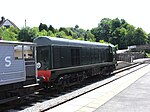 |
Class 20 Locomotive Society | Midland Railway - Butterley |
| 20 007 | 20 007 | 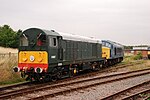 |
Class 20 189 Ltd | Mainline operational |
| 20 020 | 20 020 | 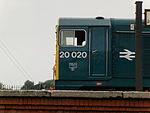 |
Scottish Railway Preservation Society | Bo'ness and Kinneil Railway |
| 20 031 | 20 031 |  |
Privately owned | Keighley & Worth Valley Railway |
| 20 048 | 20 048 | 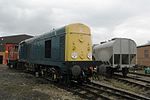 |
Midland Class 20 Association | Midland Railway, Butterley |
| 20 050 | D8000 | 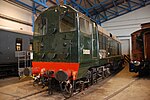 |
National Collection | National Railway Museum |
| 20 057 | D8057 |  |
Privately owned | Churnet Valley Railway |
| 20 059 | D8059 |  |
Somerset & Dorset Loco Company | Watercress Line |
| 20 069 | D8069 | 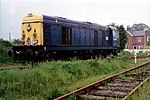 |
Privately owned | Mid-Norfolk Railway |
| 20 098 | D8098 | 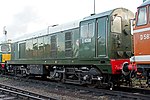 |
Type One Locomotive Company | Great Central Railway, Loughborough |
| 20 137 | D8137 | 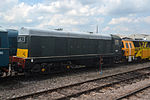 |
Privately owned | Gloucestershire Warwickshire Railway |
| 20 142 | 20 142 |  |
Class 20 189 Ltd | Mainline operational |
| 20 154 | D8154 |  |
English Electric Preservation | Great Central Railway (Nottingham) |
| 20 166 | D8166 |  |
HNRC | Wensleydale Railway |
| 20 188 | D8188 |  |
Somerset & Dorset Loco Company | Spa Valley Railway |
| 20 189 | L189 | 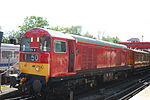 |
Class 20 189 Ltd | Mainline operational |
| 20 205 | 20 205 | Class 20 Locomotive Society | Mainline operational | |
| 20 214 | 20 214 | Privately owned | Lakeside and Haverthwaite Railway | |
| 20 227 | 20 227 | Class 20 Locomotive Society | North Norfolk Railway | |
| 20 228 | 2004 | Privately owned | Vale of Glamorgan Railway |
Another three trains remained, but were later used as spare parts and eventually scrapped. 20 035 was dismantled from class D8137 for use with a classmate D8137 of the Gloucestershire Warwickshire Railway and later scrapped at EMR Kingsbury. 20 177 was on the Severn Valley Railway and became a source of replacement parts for D8188 & D8059; the remains eventually went to CF Booth Ltd. in Rotherham. 20206 was operated by the Mid-Norfolk Railway, but was later sold by its owner, stripped of parts and scrapped.
Model trains
In 2008 Hornby Railways launched its first version of the BR Class 20 in OO gauge. Since 2016, Hornby has been producing a basic rendering of the prototype as part of its Railroad range in BR Blue.
Individual evidence
- ^ Colin J. Marsden and Graham B. Fenn: British Rail Main Line Diesel Locomotives. Oxford Publishing Co. ISBN 9780860933182 . OCLC 17916362. 1988.
- ↑ a b Michael Oakley: BR Class 20 diesels . Bradford Barton / D&EG, Truro 1981, ISBN 0-85153-419-8 .
- ↑ ' At least 20 20s' for Barrow Hill diesel jubilee . In: The Railway Magazine , July 2007, p. 9.
- ↑ a b c Monty Wells: Tweak a Twenty. In: Railway Modeller. Volume 33, No. 385. Seaton, Devon: Peco Publications & Publicity Ltd., November 1982. pp. 398-401.
- ↑ Class September 20, 27, 2013, accessed June 23, 2020 .
- ↑ BBC News | Europe | Train of Life in Kosovo. Retrieved June 23, 2020 .
- ^ SW Stevens-Stratten and RS Carter: British Rail Main-Line Diesels . Ian Allan Ltd, Shepperton 1978, ISBN 0-7110-0617-2 .
- ^ A b Graham Turner: Rail Blue - The Story . In: Rail Blue . 2012. Accessed June 24, 2020.
- ^ Graham Turner: The Class 20 Locomotive Fleet . Retrieved June 24, 2020.
- ↑ BRT Lcomotives. September 16, 2013, accessed June 23, 2020 . ( Memento in the web archive )
- ^ Railway Accident: Report on the Collision that occurred on 16th December 1971 at Lenton South Junction, Nottingham. Retrieved June 24, 2020 .
- ↑ Sinister Class 20 is new James Bond movie star. In: Rail issue 250, April 12, 1995. p. 6.
- ↑ Preserved Diesels: Class 20
- ^ Hornby Railways Collector Guide - Class - Class 20 - Diesel-Electric. Retrieved June 23, 2020 .








